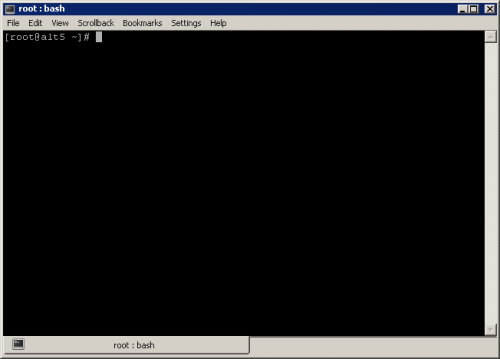Tip 1: How to restart the daemon
Tip 1: How to restart the daemon
In UNIX-like operating systems, processes that perform service functions and do not have a user interface are called demons. In the form of demons, a large numberservice software (task scheduler, logging subsystem, DBMS servers, etc.). Sometimes a particular daemon needs to be restarted.

You will need
- - access to the target machine (physical or remote);
- - root credentials.
Instructions
1
Log on to the target machine with the accountwith the root user. If you have physical access to the computer and work in a graphical environment (KDE, Gnome, etc.) run a terminal emulator, such as XTerm or Konsole. You can also switch to the text console by pressing Ctrl + Alt + Fx, where x is the console number. If the login is already made by a user other than root, run the su command. If you have SSH access to the machine, use the appropriate program to connect. On UNIX-like systems, the console client ssh is usually installed. When working under Windows, you can use the PuTTY program, which is freely distributed on putty.nl. Enter the root credentials and start the session.

2
Learn the name of the init scriptthe daemon that needs to be restarted. Usually all such scripts are in the /etc/rc.d/init.d directory and have the same names as the daemons they serve. Review the contents of this directory using the file manager or the ls command. If you know the approximate name of the daemon, filter the output of ls with the grep utility. For example, ls -1 /etc/rc.d/init.d | grep log

3
Learn about the current status of the restartedthe demon. Execute a command like: service <daemon_name> status Here, instead of the <daemon_name> tag, use the name you received in the previous step. If a line of the form <daemon_name> is running appears, the daemon works and you can restart it. Otherwise, this is impossible (such a daemon does not exist or it is stopped).

4
Restart the daemon. Execute a command like: service <daemon_name> <command> The value of <daemon_name> is similar to the one described in the third step. For the <command> parameter, use one of the known daemon command identifiers that lead to a restart (they are usually described in the documentation that comes with the appropriate package) or the --full-restart option. For example: service syslogd restartservice httpd2 gracefulservice syslogd --full-restart

5
End the current session. Type the exit command. Press Enter. You can also use the logout command to exit from the text console or disconnect from the SSH server.

Tip 2: How to restart the process
A running computer is running at the same timeset of processes. The work of most of them runs imperceptibly for the user, apparently not showing up on the screen. But when setting up a computer or finding the reasons for the incorrect operation of the operating system, the user sometimes encounters the need to stop or restart some process.

Instructions
1
All running processes are divided into launchingautomatically when the system starts and starts when the user clicks on a shortcut of a particular program. The first, in turn, are divided into the system, necessary for the operation of the OS, and the processes of user programs for which the option of autorun is installed.
2
To stop the process, you need to know his name. Open the command line: "Start - All Programs - Standard - Command Prompt". Type the tasklist command and press Enter. You will see a list of processes running in the system. If you can not determine the name of the process by its name, use the Everest program. With it, you will get all the information about your computer, including information about running processes and the path to executable files.
3
There are several ways to stop the process. The easiest is through the "Task Manager" (Ctrl + Alt + Del). Select the one you want to stop from the list of processes and right-click it. In the context menu that opens, select "End Process". Remember that you can not stop critical system processes, the operating system will not allow you to do this.
4
You can stop the process from the command line,To do this, issue the taskkill / pid command 1234 / f and press Enter. Instead of "1234" enter the process ID (PID), look in the last column of the list displayed by the tasklist command. The parameter f in the command determines the forced termination of the process. To view all the options for using the taskkill command, type taskkill /? In the command line. and press Enter.
5
If you want to stop a running service,open: "Start - Control Panel - Administration - Services". Find the service you need and double-click it. In the window that opens, click the Stop button, the service will be stopped. Then you can disable it by selecting "Disable" in the "Startup type" menu.
6
After stopping the service, you canrestart by pressing the "Start" button. The button is visible if "Auto" or "Manual" is selected in the "Startup type" menu. If the option "Disabled" is selected, the button will be inactive.
7
To start a process that is not a service and,accordingly, not displayed in the list of services, find and run its executable file. View the path to the file in the Everest program until the process is stopped. You can start the process from the command line - for example, to start Notepad, type notepad.exe from the command line and press Enter. To run the programs you have installed, you must enter the full path to the executable file.
Tip 3: How to restart your computer
In the Windows operating system, there isseveral ways to perform the same operation. If the user needs to shut down or restart the computer, you can do this in many different ways.

Instructions
1
To turn off the computer, click the "Start" buttonor the Windows key on the keyboard. Select "Shutdown", in the window that appears, click "Shutdown" with the left mouse button. This method is considered correct. To restart (restart) the computer, again use the "Shutdown" command in the "Start" menu, in the appeared window select the option "Restart".
2
If you want to end one sessionuser and restart the system to work under another scientific record, select "Log out" from the Start menu, in the new window, select the "User Change" command. You will be taken to the welcome screen, where you will be asked to select a different account and (if necessary) enter the password.
3
The shutdown and restart methods described abovesystems are also possible through the "Task Manager". To call it, press the keyboard shortcut Ctrl, Alt and Del. Another option: right-click on the "Taskbar", in the drop-down menu, select the item "Task Manager". On the top line of the "Manager" menu, select "Shutdown". In the expanded menu, select the command that you need. You can also restart the system by pressing Ctrl, Alt and Del again.
4
If the computer does not respond ("freezes"),Use the Reset button on the front of your computer. Unlike the Power button, it has a small size, so you do not confuse it with the power button even if the buttons are not signed.
5
In some cases, to restart the computeryou may need to turn it off completely. If none of the described shutdown methods help (including pressing the Power button on the computer's case), find the toggle switch on the rear panel of the system unit and set it to Off. After that, once again put it in the On state and turn on the computer in the usual way.
Tip 4: How to restart the server
The server rebootsas with its hang, and after some types of operations to update the software. You can restore the remote machine both locally and remotely.

Instructions
1
It is most convenient to use for remoterestart the server protocol VNC. To do this, install the client part of the free version of RealVNC on the local computer, and the server part of the same program on the server. If you have Linux installed on your server, you must have the X.org or XFree86 graphics subsystem on it. After launching the client, enter the name of the root user (in Linux - root, and in Windows - Administrator), its password, and the IP address of the server. After connection, you can reboot the machine through the graphical interface, just as if you were at that time near it. Do not forget to select the item in the menu that corresponds to the reboot, and not to shutdown, because you can not enable the server remotely.
2
Significantly lower channel bandwidthIt is required if the server is accessed via the SSH protocol. It is text-based, but differs from the more common Telnet protocol in that it encrypts data, which makes it difficult to intercept the password. You can connect to the server on Linux via SSH even if there is no graphics subsystem. SSH clients exist not only for computers, but also for mobile phones on the Android, Symbian, iOS and Windows Phone 7 platforms. After connecting to the server, issue the command shutdown -r now or reboot (on Linux) or tsshutdn 0 / reboot / delay: 0 (in Windows).
3
If the server is frozen and does not respond to commands,you can only reload it locally. First, try to use the reboot methods, which are regular for the OS installed on it. If this does not work, press the Reset button on its case. Then wait for the automatic check of the file system on the disks and the resume of the machine. Make sure that all sites hosted on it are accessible and functioning correctly.
4
The server may hang at night when indoorsthere is no one, and therefore a local reboot is impossible. Therefore, if you want, connect the device to it for hardware rebooting. It can be automatic (then it's called a watchdog timer) or remote. In the first case, a program running permanently on the server and changing the state of one of the ports with a periodicity of one second starts. If the state of the port has ceased to change, it is regarded as a hang-up, and the Reset button is simulated. In the second case, an imitation of pressing this button occurs when an SMS message (the content of which is known only to the administrator) arrives at the built-in radio modem.
Tip 5: How to restart the operating system
Restarting the operating system may be required in a number of different cases, for example, when installing new software, after making various changes, etc.

There are several different waysrestart the operating system. Each of these methods is used in various situations, for example, when the computer stops responding to user requests.
The standard way to reboot
In the event that the computer is functioning normally,and the operating system does not hang, then the user can use the standard way of rebooting the OS. In various versions of operating systems, the restart procedure may differ, but the principle will in any case be the same. To restart the user, you need to go to the "Start" menu, and at the bottom of it, find the "Shutdown" item. After clicking, a special pop-up menu opens, where you can select one of the presented modes, namely, "Standby", "Shutdown" or "Restart". Accordingly, in order to restart the operating system, you must select the "Restart" item. In Windows 7 and Windows Vista, you need to click on the small arrow next to "Shutdown" to restart.Reboot with the "Task Manager"
Another way to restart the operating systemYou can use it when it freezes and stops responding to any user requests. You can do this with the help of the "Task Manager". It opens with the Ctrl + Alt + Del key combination. Here the user can see all active tasks and if you find and disable the task that has the status "Does not respond," then you can close it and get rid of the need to reboot. If restarting the operating system is still necessary, then at the top of the "Task Manager" you can find the "Shutdown" item, and in the appearing context menu, click on "Restart".A Radical Method
There is another way, but it is desirableUse only when the system absolutely stops responding and it's impossible to return to the normal state. For this purpose, a Reset button is provided on the stationary personal computers, which is located directly on the case of the system unit and is usually located next to the power button. On laptops, there is no such button, but replacing it is the same power button that you just need to hold for a few seconds. It is worth noting, in this case all the information that was not saved will be completely lost.Tip 6: How to restart squid
Powerful and flexible cross-platform cachingSquid proxy server is one of the best solutions in its field. Thanks to open source and free of charge, Squid now operates on a huge number of computers connected to the Internet. To permanently or temporarily change the work parameters, sometimes you need to restart Squid.

You will need
- - root credentials.
Instructions
1
Start the terminal emulator or switch totext console. If the work is done in any graphical environment (KDE, Gnome, etc.), the emulator program shortcuts can be found in the main shell menu. If you can not find them, try using the application launch functionality, also available from this menu. If there are no suitable programs, install them using, for example, Synaptic. If the terminal emulator is not used in the graphical environment, switch to the text console. To do this, press one of the keyboard shortcuts Ctrl + Alt + F1- Ctrl + Alt + F12.

2
Start the root session. In the terminal emulator, run the su command. Then enter the root credentials (both in the graphical and text console).

3
Ask the current status of the squid daemon. Enter the command: service squid status Analyze the displayed text. A message like squid is running indicates that the squid service is functioning. The text squid is stopped says that the proxy server is not running, and the service: squid: Unrecognized service line will appear if Squid is not installed. In case Squid is installed, but does not work, run it with the command: service squid startIf necessary To install this software, use Synaptic or the apt-get package manager. Install the installation from the command line with the command: apt-get install squid

4
Restart Squid with the default settings. Run the following command: service squid restart Wait for the restart process to finish.

5
If the purpose of the restart is to changeSquid execution parameters, determine how long it should work with the new options. If new parameters need to work constantly, edit the configuration file squid.conf and restart in the manner described in the fourth step. If you need to start the proxy server with the parameters changed for a short time, stop it with the command: service squid stop Display the command line help Squid: squid -h Start the server from the console by specifying the options on the command line.

Tip 7: How does a demon get into a human
How does a demon get into a human being? In esotericism, it is believed that obsession is the infusion of an evil spirit that negatively affects a person and often leads him to death. Determine that a person has become a devil, you can by several criteria.

Instructions
1
Aggression. Excessive aggressive behavior and uncontrolled bouts of anger may indicate that a demon has settled into a person. Irrelevant irritability is becoming more frequent. A person ceases to perceive his actions logically. Outbreaks of hatred for everything around him make him commit acts of violence. He can hit a small child for a small oversight, break a glass against a wall. Nervous disruptions alternate between the possessed with extreme apathy.
2
Seizures. Attacks of epilepsy and convulsions are a manifestation of demon possession. For no reason at all, a man who was absolutely calm, in a minute begins to fight in convulsions. At the same time, he can so unnaturally bend, which causes others to be horrified. Everything can be attributed to the individual flexibility of the spine, but this is not the only explanation.
3
Loss of connection with reality. Obsession with demons manifests itself in the strange behavior of people who previously behaved absolutely adequately. They hear voices, they see what other people can not see. It's like schizophrenia, but it can also be occult.
4
Apathy. When the demon takes root more and more in the human body, the latter falls into an apathetic state. He is idle, stops going to work, communicating with relatives. Then it can degenerate into a suicidal state. The obsessed seeks to deprive oneself of life. Usually he tries to do this through stabbing and cutting objects. There is something sacred in this. So the demon tries to finally weaken the will of the possessed.
5
Knowledge of languages. If the previous reasons can be explained from the point of view of psychology, then this is clearly a paranormal phenomenon. A person who did not speak two languages, suddenly starts to speak on several. Most often these are dead languages, for example, ancient Latin or Sumerian. The voice of the obsessive can change beyond recognition. He goes on shouting, wheezing, growling, sounding from somewhere far away. Often a person can be obsessed not by one but by several demons, so they speak different languages.
6
Wrangling. The presence in the speech of obsessive scruples and vulgarity is an indispensable sign of obsession. In general, a person becomes vulgar and behaves indecently. His sexual attacks on other people can be unnecessarily provocative. Indecent behavior usually becomes one of the last criteria before the complete introduction of the demon and the displacement of the human personality.
7
Denial of religion. At the initial stages of obsession, a person negatively refers to all symbols of religion: crosses, the Bible, holy water. But in the last days the demon is so strengthened in his power that he begins to commit sacrilege on them. The obsessed spits on the crosses, holy water does not work for him at all.
8
Soreness. At the last stage of the introduction of the demon, the person looks very painful. His skin acquires a greenish-gray hue. Eyes reddened and watery. He constantly vomits, his joints ache. He stops eating, and his organs begin to gradually decline. Constant convulsions and weakening of the body lead to a fatal outcome.
Tip 8: How to draw a demon with a pencil
Demons - the creatures are fantastic, sothe artist can depict them as they are drawn in his imagination. Pencil sketches can serve as the basis for a more complex work done with colors. But before a successful sketch comes out, you need to make a lot of variants of drawings, connecting all your imagination and ability to own in pencil.

You will need
- - a pencil;
- - The eraser;
- - paper.
Instructions
1
Mark the composition of the picture. If apart from Demon there will be other characters and objects, give them space on paper. Note with light strokes the top, bottom and width of the figure Demon.
2
If you are planning to draw large wings,designate their outlines so that they fit on the selected sheet of paper. Divide the shape into details: the oval of the head, trunk, arms, legs. Gradually add specificity, highlighting the torso, hand movement, angle of rotation of the head and so on.
3
Gradually the figure Demon will take shape in the figure. Erase excess lines. Think about what objects can be in the otherworldly creature in the hands, what will be its horns, hair, skin, claws, clothing. "Try on" all this on your figure, if you see that the part does not fit the nature of the drawing, delete it.
4
Label the shape of the wings Demon. The shape of the angels' wings is often used,only black, you can depict them as broken, with bared bones, or fluffy and wide. More common option - leathery. You can draw them thin and ragged, like a bat, or strong and with spikes, like a dragon's.
5
Look for new forms, try to draw an ornament on the horns or a tattoo not the body Demon. It can be bald with sharp triangularears or wear long hair with a bizarre hairdo. The figure must be harmonious, the detail of the pattern on the weapon can repeat the element of the tattoo or decoration.
6
Draw the lines of muscles on the body of the creature. Go on to smaller details - claws, ears, details of clothes and, of course, face Demon. First, outline the location of eyebrows, eyes, nose and mouth. When you achieve an organic combination of shapes and sizes, go to a more detailed drawing.
7
Enlist your Demon character. This can be done by giving a special bend to the lips and eyebrows of the creature, with the help of a cunning eye squint and a bent tip of the nose. Draw the lines of the cheekbones so that the face becomes clear.
8
Finish the drawing, erasing the unnecessary and firmly outline the outline. Draw the entourage of the picture - the surrounding Demon objects and phenomena.







